What kind of good tea is there in Africa? Which countries in Africa have tea producing areas? What is the function and effect of African tea?
Africa has rich and diverse cultures, but they all have one thing in common, that is, the appreciation of tea. Tea plays a central role in social rituals throughout continental Europe, whether as a snack for food or as a way to entertain guests. The types and service styles of tea in different regions are different, which makes African tea culture have a pleasant diversity and endless changes to explore. For example, mint and sugar-flavored green tea is preferred in North African countries such as Morocco, Egypt and Tunisia, as well as in West African countries such as Senegal, Mauritania and Gambia. At the same time, in countries such as Mauritius and Kenya, black tea is served with milk and sugar, a style reminiscent of the former British colonists in the region. There are also some local specialties, such as Rui Persian tea in South Africa, an herbal brewing tea popular for its wholesome properties, and Somali Shah tea, a mixture of black tea and sugar, seasoned with cinnamon, ginger, nutmeg, cloves and cardamom.

Tea production in Africa although tea is a relatively new crop in Africa, the African continent has rapidly emerged on the global stage as the world's fourth largest tea producer. Almost every African country now grows at least a small amount of tea, and the most common crop is CTC black tea, which is used to make tea bags. Malawi was the first African country to engage in tea production and the first commercial plantation was established in the 1880s. In 1903, Kenya followed, becoming the largest tea producer in Africa today, with a planting area of more than 4000 square miles. Tanzania and South Africa are also famous for producing brightly colored and rich black tea, as is Zimbabwe, which grows tea on specially irrigated estates. The types and tasting places of African tea although most of the tea crops in Africa are exported, during your visit to the continent, you can still taste the local tea varieties, or at least experience the local tea drinking style. For example, you can try some fresh local rooibos or crispy black tea from the garden of KwaZulu-Natal province (KwaZulu-Natal) in South Africa, or mellow brewing tea from Luponde Estate in Tanzania. Similarly, after a day of bustling markets and charming historic buildings in Morocco or Egypt, a cup of sweet mint tea is the perfect pick-me-up.
Important Notice :
前街咖啡 FrontStreet Coffee has moved to new addredd:
FrontStreet Coffee Address: 315,Donghua East Road,GuangZhou
Tel:020 38364473
- Prev

Introduction to India's main tea producing areas Darjeeling tea producing areas and Assam tea producing areas Basic overview
Tea was a great legacy left to India by the British colonists. India now has three major tea producing regions: Darjeeling in the north, Assam in the northeast, and Nilgiri in the south. Among them, India's Darjeeling tea and Assam tea are world-famous, which also makes India the world's largest tea exporter.
- Next

How do espresso drink flavor characteristics describe espresso is bitter? What kind of coffee beans are not bitter?
"what's so good about this bitter stuff?" This should be the impression of many people on espresso. When many people first came into contact with espresso, they walked into a cafe, saw the unit price on the menu, gently wiped a cold sweat, and trembled to order a cup of coffee with the lowest unit price. Unexpectedly, one was brought up.
Related
- Beginners will see the "Coffee pull flower" guide!
- What is the difference between ice blog purified milk and ordinary milk coffee?
- Why is the Philippines the largest producer of crops in Liberia?
- For coffee extraction, should the fine powder be retained?
- How does extracted espresso fill pressed powder? How much strength does it take to press the powder?
- How to make jasmine cold extract coffee? Is the jasmine + latte good?
- Will this little toy really make the coffee taste better? How does Lily Drip affect coffee extraction?
- Will the action of slapping the filter cup also affect coffee extraction?
- What's the difference between powder-to-water ratio and powder-to-liquid ratio?
- What is the Ethiopian local species? What does it have to do with Heirloom native species?

